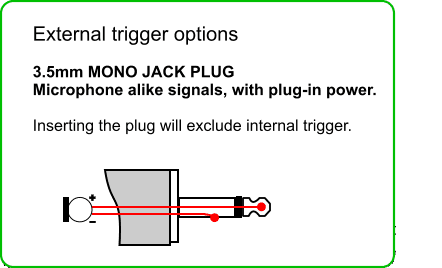Intervalometer, Trigger, Stop Motion and Dolly Controller

I first designed this unit in October 2010, in an attempt to promote the LCD Programmable Controller (named LCDG) over which this unit is made around, and making something useful for me to take shots for time lapse videos.
The company which produced those devices eventually went out of business, but the unit is still with me, as well as a bunch of LCDG Programmable Controllers (a post will follow with a full description). It is a pity to toss those clever devices, so I recovered them and added some improvements to the operating system, and now I think they are a really valuable piece of hardware for making devices such as the intervalometer presented in this page.
What an Intervalometer is?
An Intervalometer is a device that sends control commands at regular intervals, and may be used for some application in medical apparatus, chemical processes and even military application, but one of the most common one is photograpy and videography.
So what a photographer/videographer can do with it? Usually you take a sequence of pictures at regular intervals, then you bring them all into a video editing software to create a time lapse video. Search for "time lapse" in Vimeo or YouTube and you'll get the idea.
The Intervalometer I've made has the capability to command up to thirty thousands takes, that's a lot of pics! These pictures may be taken in a span of up to 24 hous, minus one minute, at intervals between one second to one hour. Furthermore you may also control the length of the exposition from one second to four minutes and 13 seconds (254 seconds, this require to set your camera in bulb mode). Other functions are included: the Trigger (to take pictures from events such as sudden light changes, or sounds or other external events/signals), the Stop Motion aid (take shots for animations) in conjuction with a motorized dolly or table motion or even a go motion. Well, I've mentioned a motirized dolly, indeed it also have a Dolly Controller to move the camera between shots (SHOT-MOVE-SHOT mode) and while shooting (CONTINUOUS-MOVE-SHOT mode).
An Intervalometer ...and much more
Table of contents:
Overview Details of functions Circuits About the display-programmable controller
Overview
This unit may perform several useful function: intervalometer for time lapse videography, trigger for capturing pictures
upon sudden changes in light or from external sensors such as a microphone, stop motion sequences, and to control a
motorized dolly.
It is designed to work primarily with Canon cameras, I tested it with a 60D. However, rewiring with a
proper connector many other cameras can be controlled as well.

Main characteristics
POWER SUPPLY:
Nominal voltage:
Current consumption:
Protections:
6 AAA NiMH (rechargeable) or Alkaline (cannot be recharged) batteries.
8.4V; Low battery voltage: 7.2V; max voltage: 9.8V
80mA (with back light on); max instant peak: 95mA (about 50mA when back light is off).
Fuse 250mA + inverse diode protection against wrong polarity.
CAMERA SHUTTER AND FOCUS CONTROL:
Optoinsulated. Collector-emitter will close to COMMON when opening shutter/focusing, max voltage 15V,
max current 10mA.
CAMERA SHUTTER CONTROL:
Manual/Stop Motion and automatic by interval or trigger, default release time: 100ms.
CAMERA FOCUS CONTROL:
Manual only. Pulse focus 4 seconds before opening shutter on intervals longer than 10 seconds (wake up function);
release time: 100ms.
Intervalometer:
up to 30000 shots, time duration up to 23h 59' and 59", interval from 1 second to 3600 seconds,
hold time (useful with bulb setting in your camera) from 1 second to 254 seconds.
Trigger:
- Voltage range at input processor: 0 ÷ 5V; Static voltage at input processor (default value 150): 2.925V;
- Preamplifier AC gain: +74dB (preamp: Zin=~1KO; Zout=~12KO);
- Sensitivity attenuation: 0dB ÷ -50dB (approx.)
- Propagation time between trigger and shot: < 200 us.
- Detection and Response time: on light change: 1.5 ms; on external signal change: 1 ms
- Minimum slew rate time: 50V/s (0.5V / 0.01s)
- Minimum frequency/amplitude response: 10Hz / 0.5V
Trigger Settings:
- Trigger threshold 0 to 255 (default 150)
- Slope (trigger on greater or smaller values than threshold)
- Delay between triggers: 0 to 25.4 seconds, granularity 0.1 s
- One Shot Mode: delay longer than 25.4s change in One Shot mode.
- AC signal min. 4mVpp, max 1Vpp; plug-in power: 5V/3900ohm; Z = 3K9ohm. Adjustable sensitivity
Stop Motion:
- Shot-and-hold, release shutter and keep released for 1 to 254 seconds (with bulb mode)
- Shot-Move-Shot and Continuous-Move-Shot modes with dolly enabled.
Dolly Control:
- Can control a Dolly Driver to move the camera after each shot or continuously for video live.
- Up to 30000 steps per shots, auto zero and home, manual test as a single shot.
(The Dolly Driver is a unit that I will discuss in an other article.)
Data Link:
RS485 L (low slew rate, low load, up to 127 units can be connected together), data protocol: SFBP (Simple Field Bus Protocol).
The unit can communicate not only with the Dolly Driver, but also with other units for synchronized operations,
or a computer for monitoring or other applications (require to develop a specific software, a DLL for windows (32 bit)
makes it easy to implement the bus communication).



Don't miss next post
Subscribe to stay up to date when new articles, videos or other contents are available.
RELATED ARTICLES
RECENT ARTICLES


 Subscribe
Subscribe![Validate my Atom 1.0 feed [Valid Atom 1.0]](../valid-atom.png)